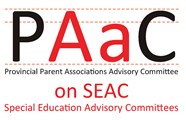The Provincial Parent Associations Advisory Committee on Special Education Advisory Committees (PAAC on SEAC) was founded in 1983, at a time when the roles and responsibilities of school board Special Education Advisory Committees (SEACs) were being increased. Bill 82, An Act to Amend the Education Act, was passed in 1980 and required school boards to provide special education programs and services to exceptional pupils, or purchase the services from another school board. School boards were given five years to implement Bill 82, and establish special education plans, in consultation with their SEACs.
PAAC on SEAC was established to provide a forum for representatives from provincial parent associations to share ideas and strategies and address common concerns related to SEACs throughout the province, and the fact that it has lasted almost 36 years is a testament to the passion and dedication of the volunteers and leadership from the parent associations.
Throughout the 36 years, PAAC on SEAC has maintained a relationship with the Ministry of Education, and continues to be invited to government consultations on matters concerning special education. Representatives from the Ministry of Education Special Education Policy and Programs Branch regularly attend PAAC on SEAC meetings. Membership of PAAC on SEAC has varied over the years and continues to evolve. There are currently 16 provincial parent association members, and new members are welcome. (See section 1.1 for current membership information.)
Over the years the expectations of school board SEACs have also changed. Most significantly, the provincial government amalgamated school boards and changed the way education is funded in 1998. The Ministry of Education has issued numerous Regulations, Policy/Program Memorandums and Resource Guides that pertain to special education and of particular significance is Regulation 464/97 regarding Special Education Advisory Committees. (See Appendix 1 for a complete copy of Regulation 464/97.) This Regulation consolidated successful practices and mandated many aspects of SEAC including:
- Membership Eligibility
- Number of Meetings
- Election of Chair and Vice Chair
- Roles of SEAC
- Expectations of school board
PAAC on SEAC has developed numerous resources to support SEAC members and this new handbook incorporates many of the effective practices cited in earlier PAAC on SEAC documents, along with new recommendations that reflect the additional expectations and responsibilities of SEACs today.
